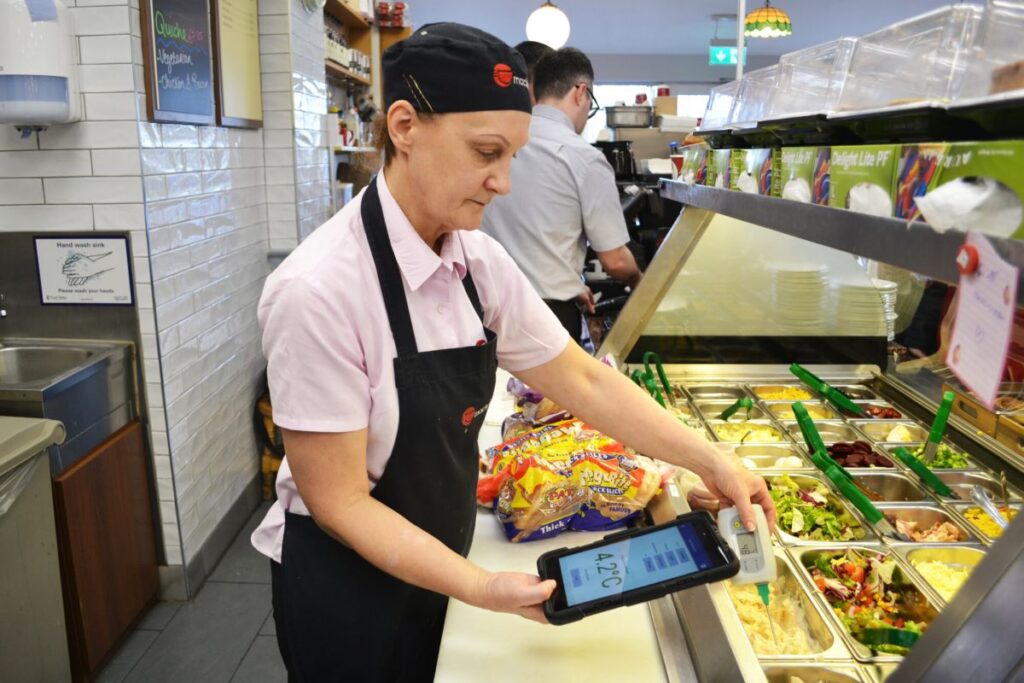In the fast-paced world of food service and production, maintaining the right temperature for food items is crucial. Automated food temperature monitoring systems have emerged as a solution that not only mitigates risks associated with food safety but also saves valuable time for businesses. This article delves into how these systems work, their benefits, and why they are becoming an essential part of the food industry.
The Importance of Temperature Control in Food Safety
Temperature control is a fundamental aspect of food safety. When food is stored or cooked at incorrect temperatures, harmful bacteria can thrive, leading to foodborne illnesses. The World Health Organization (WHO) estimates that millions of people fall ill each year due to contaminated food. Therefore, ensuring that food is kept at safe temperatures is not just a regulatory requirement; it is a moral obligation for food businesses.
Understanding the Temperature Danger Zone
The temperature danger zone is defined as the range between 5°C and 60°C, where bacteria can multiply rapidly. Keeping food out of this zone is essential for preventing spoilage and ensuring safety. Automated temperature monitoring systems help maintain this control by continuously tracking temperatures and alerting staff when deviations occur. These systems can also provide invaluable data for analysis, helping businesses identify patterns and potential weaknesses in their food handling processes. By understanding how long food remains in the danger zone, establishments can implement more effective training and procedures to mitigate risks.
Regulatory Compliance and Best Practices
Food businesses are required to comply with strict health regulations that mandate proper temperature control. Automated systems can simplify compliance by providing accurate records of temperature readings, which can be crucial during inspections. This not only helps in adhering to legal requirements but also demonstrates a commitment to food safety. Furthermore, regular training sessions for staff on the importance of temperature control and the correct use of monitoring equipment can foster a culture of safety within the workplace. Engaging employees in discussions about real-life scenarios and the consequences of negligence can reinforce the significance of these practices and encourage a proactive approach to food safety.
How Automated Monitoring Systems Work
Automated food temperature monitoring systems utilise sensors and software to track temperatures in real-time. These systems can be integrated into various stages of food handling, from storage to cooking, ensuring that every aspect of temperature control is covered. By employing advanced technology, these systems not only enhance food safety but also streamline operations, allowing businesses to focus on delivering high-quality products to their customers.
Real-Time Monitoring and Alerts
One of the key features of automated systems is real-time monitoring. Sensors placed in refrigerators, freezers, and cooking equipment continuously collect temperature data. If a temperature fluctuation occurs, the system sends immediate alerts to staff via SMS or email, allowing for prompt action to rectify the situation. This proactive approach is crucial in preventing food spoilage and ensuring compliance with health regulations. Furthermore, the ability to monitor multiple locations simultaneously means that businesses can maintain oversight across various facilities, enhancing operational efficiency.
Data Logging and Reporting
Automated systems also log temperature data over time, creating a comprehensive record that can be invaluable for audits and inspections. This data can be easily accessed and analysed, providing insights into temperature trends and potential areas for improvement. Regular reporting helps in identifying patterns that may indicate equipment malfunctions or human error. Moreover, these reports can serve as a powerful tool for training staff, as they highlight specific instances where temperature control may have faltered, thus fostering a culture of accountability and continuous improvement within the organisation. By harnessing this wealth of information, businesses can not only enhance their compliance with food safety standards but also build a reputation for quality and reliability in the eyes of their customers.
Benefits of Automated Temperature Monitoring
The advantages of implementing automated food temperature monitoring systems are numerous. From enhancing food safety to improving operational efficiency, these systems can transform the way businesses manage temperature control.
Enhanced Food Safety
By continuously monitoring temperatures and providing immediate alerts, automated systems significantly reduce the risk of foodborne illnesses. This proactive approach allows businesses to address potential issues before they escalate, safeguarding both customers and the reputation of the establishment.
Time and Labour Savings
Manual temperature checks can be time-consuming and prone to human error. Automated systems streamline this process, freeing up staff to focus on other essential tasks. The time saved can be redirected towards improving service quality or enhancing food preparation processes, ultimately benefiting the business’s bottom line.
Cost Efficiency
While the initial investment in automated monitoring systems may seem substantial, the long-term savings can be significant. By preventing food spoilage and reducing the risk of costly recalls or health inspections, businesses can save money in the long run. Additionally, the efficiency gained through automation can lead to increased productivity and profitability.

Implementing an Automated Monitoring System
For businesses considering the transition to automated food temperature monitoring, the implementation process can be straightforward. However, careful planning and consideration are essential to ensure a smooth integration.
Choosing the Right System
There are various automated monitoring systems available on the market, each with unique features and capabilities. It is crucial to assess the specific needs of the business, such as the types of food handled, the size of the operation, and budget constraints. Consulting with industry experts can provide valuable insights into selecting the most suitable system.
Training Staff
Once a system is chosen, staff training is vital for successful implementation. Employees must understand how to operate the system, respond to alerts, and interpret data logs. Regular training sessions can help reinforce the importance of temperature control and ensure that everyone is on the same page.
Case Studies: Success Stories in the Industry
Numerous businesses have successfully adopted automated food temperature monitoring systems, reaping the benefits of enhanced safety and efficiency. These case studies highlight the tangible advantages that can be achieved.
A Local Restaurant Chain
A popular restaurant chain in Australia faced challenges with maintaining consistent food temperatures across its multiple locations. By implementing an automated monitoring system, the chain was able to reduce temperature-related incidents by 80%. The real-time alerts allowed staff to address issues promptly, resulting in improved customer satisfaction and a significant reduction in food waste.
A Food Manufacturing Facility
A large food manufacturing facility struggled with compliance and record-keeping for temperature control. After integrating an automated monitoring system, the facility not only improved its compliance rates but also streamlined its reporting processes. The time saved on manual checks allowed staff to focus on quality control, leading to a notable increase in production efficiency. You may like to visit https://mazidttlimited.com/choosing-the-right-wireless-temperature-monitoring-system-for-your-kitchen/ get about choosing the right wireless temperature monitoring system for your kitchen.
The Future of Food Temperature Monitoring
As technology continues to evolve, the future of food temperature monitoring looks promising. Innovations such as IoT (Internet of Things) connectivity and advanced analytics are set to enhance the capabilities of automated systems even further.
Integration with Other Technologies
Future systems may integrate with other technologies, such as inventory management and supply chain systems, providing a holistic approach to food safety and operational efficiency. This interconnectedness can lead to more informed decision-making and a proactive approach to food safety.
Emphasis on Sustainability
With growing awareness of sustainability in the food industry, automated monitoring systems can play a role in reducing food waste. By ensuring optimal storage conditions and minimising spoilage, businesses can contribute to a more sustainable food system while also benefitting their bottom line.

Conclusion
Automated food temperature monitoring systems are revolutionising the food industry by enhancing safety, saving time, and improving operational efficiency. As businesses continue to prioritise food safety, the adoption of these systems will likely become the norm rather than the exception. By investing in technology that ensures proper temperature control, food businesses can protect their customers, their reputation, and their bottom line.
In an era where food safety is paramount, embracing automated solutions is not just a smart choice; it is a necessary step towards a safer and more efficient food industry.


